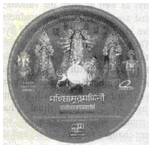Rituals
Durga Puja is said to be the festival of kings,
So grand and elaborate are the paraphernalia involved. The process is detailed in a number of Puranas.’ While most other pujas are done in a day or two, Durga Puja takes a minimum of four. The requirements, too, entail that preparations for the Puja begin months in advance. A look at the ingredients for mahasnan, ‘the daily bath of the goddess, for instance, reveals how it involves the high and the low, the near and the far, the little and the great, the bitter and the sweet, totalling to almost 75 items!3 Durga is, after all, the goddess of all things and beings.
Topping the list is 18 types of soil—from an ant-hill, a mountain, a temple door, a palace door, a prostitute’s door, both sides of a river and a four-cornered crossing, to name a few. The relevance of soil from the prostitute’s door may seem to be a questionable inclusion on a holy occasion. But the logic behind the choice is that men leave their virtues behind at the doorstep of a prostitute’s chamber, making the spot a potent one. This is also a way to recognise her place in a festival that encompasses all strata of society.
The celebration of power is reflected in prescriptions for soil dug out by a boar with its tooth, by an ox with its horns and by an elephant with its tusk.
The water required is also no less varied—hot, cold, rain water, from the sea, the fountain, the pond, dew collected on lotus pollens, from the Ganga, from the Saraswati (a major North Indian river in Vedic times but now more of a mythical entity) as well as from the various pilgrimages.
Also needed are five jewels, five produces of the cow, extracts of five bitter fruits and a mix of five sweetening ingredients. The water is scented with extracts of fragrant woods and then poured from various containers—pots, pitchers and sprinklers with 1,000 nozzles. There are directives of even the kind of music and the instruments that are to be played during the Devi’s bath. For instance, when rainwater is used for the bathing ritual, it has to be Raga Lalit and the trumpet while during a spring water bath, the accompaniment changes to Raga Baradi and the blowing of conch shells.
Of course, it is not the clay image that is bathed. The water is poured on a mirror, capturing the goddess’ reflection. It is after this elaborate affair that the puja starts.
Pitritarpan (tribute to the forefather): On Mahalaya, the day before the divine fortnight, the banks of the holy river Ganga are crowded with men immersed in waist-deep water, facing the sun and chanting mantras with hands clasped. It is time to offer water to the forefathers. This is the day of the new moon preceding the divine fortnight. Though during this period, it is night in heaven and the gods are asleep, it is daytime in the nether world and the inhabitants of this region are up and thirsty. On this day, the distance between the terrestrial and the nether world is said to be the least. Pitritarpan may not be directly linked to the Puja, but the Hindu religion places so much importance on duties to the ancestors that such offerings are mandatory for the Puja to take place. Even Rama, the epic hero of the Ramayana, had to propitiate his forefathers in the Ikshaku family before invoking Durga.
Hymns
 Nowhere has Raghunandan, the great 16th century Sanskrit scholar, mentioned this in his celebrated methodology of Durga Puja, but Mahalaya today is incomplete without a radio broadcast at dawn. A reading of Shri Shri Chandi in the sonorous voice of Birendra Krishna Bhadra, interspersed with devotional songs, wakes people up to the delightful message that the Pujas are here. The programme, which has attained cult status, was first broadcast in 1930, but on a Sashthi morning. On getting a nod from the then station director of All India Radio, J.R. Stapleton, the team of PremankurAtarthi, Nripendranath Majumdar, Raichand Boral, Pankaj Mullick, Banikumar, Bhadra and others got cracking. At 2 am, the artistes, dressed in traditional Bengali attire, would be picked up from home for what was for the first few years a live broadcast. Later, the audio rights of the programme were sold to the Gramophone Company of India, and the Mahishasuramardini album has remained the top grosser every Puja ever since. Such is its popularity that the music company has even brought out a VCD based on the radio programme. Today, the television channels also beam audiovisual versions of the destruction of the buffalo demon, but nothing matches up ‘to the vintage Bhadra and company.
Nowhere has Raghunandan, the great 16th century Sanskrit scholar, mentioned this in his celebrated methodology of Durga Puja, but Mahalaya today is incomplete without a radio broadcast at dawn. A reading of Shri Shri Chandi in the sonorous voice of Birendra Krishna Bhadra, interspersed with devotional songs, wakes people up to the delightful message that the Pujas are here. The programme, which has attained cult status, was first broadcast in 1930, but on a Sashthi morning. On getting a nod from the then station director of All India Radio, J.R. Stapleton, the team of PremankurAtarthi, Nripendranath Majumdar, Raichand Boral, Pankaj Mullick, Banikumar, Bhadra and others got cracking. At 2 am, the artistes, dressed in traditional Bengali attire, would be picked up from home for what was for the first few years a live broadcast. Later, the audio rights of the programme were sold to the Gramophone Company of India, and the Mahishasuramardini album has remained the top grosser every Puja ever since. Such is its popularity that the music company has even brought out a VCD based on the radio programme. Today, the television channels also beam audiovisual versions of the destruction of the buffalo demon, but nothing matches up ‘to the vintage Bhadra and company.
